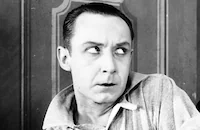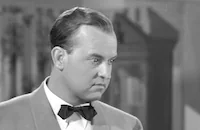Vivacious Lady

Brief Synopsis
Cast & Crew
George Stevens
Ginger Rogers
James Stewart
James Ellison
Beulah Bondi
Charles Coburn
Film Details
Technical Specs

Synopsis
When Peter Morgan, a young botany professor from Old Sharon, New York, goes to Manhattan on orders from his father to bring back his wayward cousin Keith, he instead falls in love with Francey, a high-spirited nightclub singer. After a day of starry-eyed courtship, Francey and Peter marry, but are unable to consumate the union on the train to Old Sharon. The couple then must face Peter's domineering, conservative father when they arrive at the university town. Upon seeing blonde Francey at the train station, Mr. Morgan immediately assumes that she is Keith's lover and refuses to discuss her with his son. Afraid of upsetting his heart-troubled mother, Peter decides to tell his parents and Helen, his snobbish fiancée, about his marriage at the school prom and sends Francey off to stay with Keith in his bachelor apartment. Posing as a botany student, Francey shows up at the prom with Keith, but before Peter can bring his parents and new wife together, Francey is taunted into a hair-pulling brawl with the jealous Helen. Worried about his cousin's penchant for womanizing, Peter tells Francey to leave Keith's place, and she moves into a women-only apartment building. Finally, Peter manages to tell his father about Francey, and after the initial shock of the news wears off, he condemns the marriage. In the wake of her husband's fury, Mrs. Morgan falls ill. The next day, however, having been told by Helen that Francey has seduced her son, Mrs. Morgan goes to confront Francey in her apartment and happily learns the truth. Mr. Morgan arrives and orders Francey to divorce Peter, but Mrs. Morgan revolts and decides to leave her husband. Having revealed that she has been feigning her heart attacks, Mrs. Morgan leaves Old Sharon on the same train as a depressed, discouraged Francey. The two women and their husbands are soon reunited on the train after Peter successfully challenges his father's authority and convinces him that love is more important than either image or career.

Director

George Stevens
Cast

Ginger Rogers

James Stewart

James Ellison

Beulah Bondi

Charles Coburn

Frances Mercer
Phyllis Kennedy

Franklin Pangborn

Grady Sutton

Jack Carson
Alec Craig

Willie Best

Hattie Mcdaniel
Dorothy Moore
Frank M. Thomas
Spencer Charters

Maude Eburne

Bud Flanagan
William Brisbane

Lloyd Ingraham
Crew
Russell Bennett
Henry Berman
Pandro S. Berman
Anne Morrison Chapin
Carroll Clark
Roger Edens
Robert De Grasse
Irene
George Jessel
Hugh Mcdowell Jr.
Jack Meskill
Argyle Nelson
Bernard Newman
Ernest Pagano
Van Nest Polglase
Ted Shapiro
Darrell Silvera
George Stevens
Roy Webb
P. J. Wolfson

Photo Collections
Videos
Movie Clip



Trailer
Film Details
Technical Specs

Award Nominations
Best Cinematography
Best Sound
Articles
Vivacious Lady
As the professor delays explaining the presence of this beautiful young woman, the complications build and build leading to one of the most hilarious scenes ever shot. A meeting between the new bride and the former fiancee'slowly builds from a few harsh words to a slap to a knockdown brawl. Ginger Rogers recalled, "The entire scene came out of director George Stevens' immense gift for comedy and was choreographed as carefully as any ballet. It starts with words, moves to slaps and kicks, and culminates in a pseudo-wrestling match. Since I was on the receiving end of the kicks, the prop department wrapped my legs with boards. When Frances Mercer slammed her high heels against my shins, I was protected by the padding, though you wouldn't know it by my pained facial reactions."
Director George Stevens is best known today for his serious films such as A Place in the Sun (1951) and Giant (1956). He made his start, however, working on the classic short comedies of Laurel and Hardy and adapted one of the team's funniest gags here: the minor confrontation that builds and builds to utter destruction. Stevens had worked before with Ginger Rogers directing her and Fred Astaire in one of their most successful musicals, Swing Time (1936).
For her co-star, Ginger Rogers chose James Stewart. At the time this film was made Stewart had not yet become the major star he would soon become, but he and Rogers had dated a couple of years before and she thought he could provide both the shyness and the romantic spark for his role. George Stevens was very happy with Stewart's performance: "He is an instinctual rather than a trained actor, but he has a wonderful knack for paradox and surprise and character-transformation, and in Vivacious Lady he rang all the changes!"
Beulah Bondi, then best known for costume dramas such as Of Human Hearts (1938) and The Gorgeous Hussy (1936), also performs a great comic turn as the professor's mother, feigning heart seizures at the threat of any upsetting news. Rounding out the cast are such professional scene-stealers as Franklin Pangborn, Jack Carson and Grady Sutton. Rogers sings "You'll Be Reminded of Me" and dances to "The Big Apple." This excellent comedy concoction received two Academy Award nominations for Best Sound and Best Cinematography.
Producer/Director: George Stevens
Screenplay: Ernest Pagano, P.J. Wolfson
Art Direction: Carroll Clark, Van Nest Polglase
Cinematography: Robert de Grasse
Editing: Henry Berman
Music: Roy Webb
Cast: Ginger Rogers (Francey Brent), James Stewart (Peter Morgan), James Ellison (Keith Morgan), Beulah Bondi (Martha Morgan).
BW-91m. Closed captioning.
by Brian Cady

Vivacious Lady
Quotes
Trivia
After four days of shooting in April 1937, 'Stewart, James' became ill, but then left to star in Of Human Hearts (1938). RKO considered replacing Stewart, but shelved the production until December 1937. Actors 'Crisp, Donald' and Fay Bainter (as well as others) who were cast in the original production were replaced by Charles Coburn and Beulah Bondi.
Notes
Production on this film began in April 1937, according to Hollywood Reporter news items and production charts. When James Stewart became ill after four days of shooting and then had to leave to star in M-G-M's Benefits Forgot, the project was shelved until mid-December 1937. Although George Stevens continued as director, some cast members were replaced in the production, including Fay Bainter and Donald Crisp. According to Hollywood Reporter, after Stewart's departure, RKO considered replacing him with Douglas Fairbanks, Jr. Hollywood Reporter also announced that James Ellison and Fairbanks were competing for the same role. RKO borrowed Stewart from M-G-M for the production. One January 1938 Hollywood Reporter production chart lists Kay Van Riper as a co-screenwriter with Anne Morrison Chapin, who is credited by the Screen Achievements Bulletin as a treatment writer. Riper's contribution to the final film has not been determined. One reviewer advised exhibitors to screen this film before booking it, as he feared that younger, impressionable viewers might forget that "Francey" and "Peter" were married. Robert de Grasse received an Academy Award nomination for his photography on the production. Although Hugh McDowell, Jr. is credited on screen as sound recorder, James Wilkinson, the head of RKO's sound department, received an Academy Award nomination for Best Sound. Modern sources add the following actors to the cast: Maurice Black (Head waiter), June Eberling (Girl on bus), Marvin Jones (Boy on bus), Bobby Barber (Italian), Ray Mayer and George Chandler (Men on train), Harry Campbell, June Johnson, Kay Sutton, Phyllis Fraser, Edgar Dearing, Helena Grant, Vivian Reid, Vernon Dent, Kathleen Ellis, June Horne, Dorothy Johnson, Phoebe Terbell, Robert Wilson, Stanley Blystone and Barbara Pepper. In addition, modern sources credit Mel Berns with make-up and John Miehle with still photography.

Miscellaneous Notes
Released in United States 1938
Released in United States 1938














